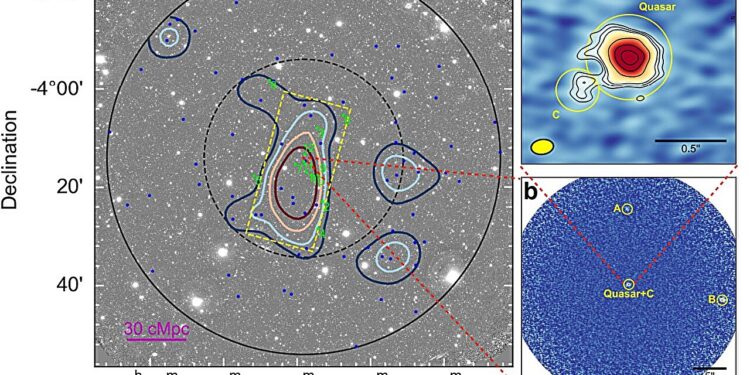Large-scale Lyhman-alpha emitter (LAE) overdensity around quasar J0910-0414. Credit: Wang et al., 2024.
Astronomers at the Steward Observatory in Tucson, Arizona and elsewhere are reporting the detection of a massive new protocol. The structure was discovered around a bright quasar known as J0910-0414. The discovery was detailed in a paper published February 2 on the preprint server. arXiv.
Galaxy clusters are home to hundreds or even thousands of galaxies held together by gravity. They are the most gravitationally immense structures in the universe and could serve as excellent laboratories for studying the evolution and cosmology of galaxies.
Astronomers are particularly interested in the study of protoclusters of galaxies, ancestors of clusters. Such objects, found at high redshifts (greater than 2.0), could provide essential information about the early phases of the universe.
Recently, a team of astronomers led by Feige Wang of the Steward Observatory used the Hyper Suprime-Cam (HSC) on the Subaru Telescope, the Atacama Large Millimeter/submillimeter Array (ALMA), and other ground-based facilities , to observe J0910-0414—a luminous quasar at a redshift of 6.63. The quasar hosts one of the most massive supermassive black holes (around 3.6 billion solar masses) with such a high redshift. For this reason, it is a good place to look for galaxy overdensities and therefore new galaxy clusters as well as the first protoclusters.
“The Subaru/HSC observations were obtained from November 2019 to January 2020. We observed this quasar field with the i2, z and NB926 filters and the source exposure times are 150 minutes, 240 minutes and 313 minutes respectively. minutes,” the researchers said. wrote in the newspaper.
The observations found a protocol anchored by J0910-0414, which includes at least three carbon (C II) lines and 12 Lyhman-alpha emitters (LAE) at the quasar’s redshift. The images also show a double-peaked LAE near the quasar.
According to the study, the new protocol is one of the densest structures known in the early universe. In addition, the current mass of this structure is estimated at around 6.9 quadrillion solar masses, three times greater than that of the neighboring Coma cluster. This means that the protocol reported in the paper is the most massive found with redshift above 6.0.
Summarizing the results, Wang’s team pointed out that it is effective to identify galaxy overdensities by targeting quasar fields with ALMA and narrowband observations, which was proven by the discovery of a new protocol.
“Future ALMA mosaic observations, narrow-band wide-field imaging, and JWST (James Webb Space Telescope) observations of quasars in the EoR (Epoch of Reionization) will not only allow us to identify galaxy overdensities in the EoR, but also to study the environmental dependence of the evolution of galaxies”, conclude the scientists.
More information:
Feige Wang et al, A massive protocol anchored by a luminous quasar at z = 6.63, arXiv (2024). DOI: 10.48550/arxiv.2402.01844
Journal information:
arXiv
© 2024 Science X Network
Quote: Astronomers discover massive protocol around a bright quasar (February 13, 2024) retrieved February 13, 2024 from
This document is subject to copyright. Apart from fair use for private study or research purposes, no part may be reproduced without written permission. The content is provided for information only.



